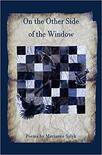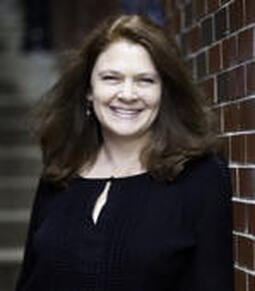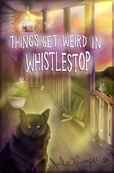Sacred Chickens
Menu
SACRED CHICKENS
 “On the Other Side of the Window” begins at the end and ends where the speaker began. Through the beginning section thoughtfully named “Looking Out at Eaarth”, the reader wanders with the poet over the dystopian Eaarth, (another name for Earth as it undergoes climate change, coined by Bill McKibben, an environmental activist and writer), and imagines with great anxiety and accuracy where we are headed. From the creep of vegetation towards our warming north: “These trees never grew this far north before”, to the juxtaposition of pollution and natural settings “the torn,/black bag/blossoming/in the water” the speaker of these poems walks through the world seeing things the way they are and the way they will end, naming all of us complicit in our environment’s demise: “We wait, take small sips/of bottled water, then wait/some more. We tourists//fly from disaster/to disaster, our quick flights/adding fuel to the flames.” In the section “Nature on the Other Side of the Glass”, the reader experiences many of the poems through the sensory technique of ekphrasis. In some poems music is described, as in the section’s title poem written in response to Charles Mingus’ Mood Indigo: “...The train ambles/past, following the rhythm of brush/strokes…” The speaker in this section seems to be looking for connection to life and sees only that which will remain after death: “I cannot find the turtle I saw/last night. Squinting, holding my breath, I//glimpse it. But it does not move./It is a turtle-shaped rock, mineral, not animal./Bronze diamond, it will stay there forever.” There is a sort of impatience for the future inherent in this section, but it is a future the speaker seems to know will never arrive. “Keyboards mimic rain.//It will not fall here./Miles’ trumpet scorches white/earth one cannot own.” If one can have nostalgia for the future, that is the feeling one gets in these poems. This section shows that the poet shares a quiet intimacy with art and music, which reveals itself through imagery in the lovely poem “Blue Green and Brown (Rothko 1952)”: “...She feels the space/between her and them dissolve.” The third section requires a sort of looking ahead based on past experience. The section title “Between Two Worlds” is fitting for the balancing act that is acheived here, again using ekphrastic poems mixed in with what I’ll call “hindsight” poems that look into the past in order to add weight to the meaning of the speaker’s future, which is of course, already known. In one of the most powerful poems in the book, “Home from the Oncologist”, a cancer patient’s thoughts about the crows on her roof mingle with the imagery of “Van Gogh’s last painting,/the murder of crows in the cornfield/a day or two before he died.” Here, the crows stand in for the dead who, she imagines, are looking for her to join them. The final section, aptly titled “Always Looking at the Past, Sometimes Living by the River” the image in the poem “The Summer After the Bridge Closed” seems to sum up the book’s overall message of environmental concerns: “Fat black crows strut down/quiet streets, across matted grass./Without hawks or humans,/crows have no need to fly.” Many of the poems in this final section look back into the speaker’s past and imagine those places once lived, those people who’ve been lost. Through the use of future tense, the poet accomplishes a great balance between memory and the wisdom gained after time passes. For example, in “When Words are Stones”: “Next spring she will watch//it carrying away black branches and corpses/through the heart of this college town.//But today she returns home.” I highly recommend reading this sensitive book of poems that travels between future, present, and past, effortlessly examining the feelings of anxiety and loss brought on by the consequences of our threatened planet. Indeed, we are “Between Two Worlds” at this crucial point, when the fate of Earth hangs in the balance.  Jessica Purdy has lived in New England all her life and currently resides in Southern New Hampshire with her husband and two children. Having majored in both English and Studio Art at UNH, she feels drawn to the visual in both art and poetry. She has worked as an art teacher and a writing teacher. Currently, she teaches Poetry Workshops at Southern New Hampshire University. She holds an MFA in Creative Writing from Emerson College. In 2015, she was a featured reader at the Abroad Writers’ Conference in Dublin, Ireland. Her poems have appeared in many journals, including The Light Ekphrastic, The Wild Word, Nixes Mate Review, Silver Birch Press "Beach and Pool Memories" Series and their "Nancy Drew Anthology", Local Nomad, Bluestem Magazine, The Telephone Game, The Tower Journal, The Cafe Review, Off the Coast, The Foundling Review, and Flycatcher. Her chapbook, “Learning the Names”, was published in 2015 by Finishing Line Press. Her book, "STARLAND" was published in 2017 by Nixes Mate Books.
0 Comments
Leave a Reply. |

Click Photo above to buy ebook or paperback from Amazon.
Here's the link to Barnes and Noble Or order through your favorite independent bookstore! Categories
All
|
 RSS Feed
RSS Feed